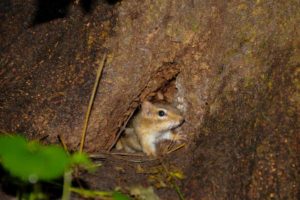Best Chipmunk Bait
DID YOU KNOW?
In addition to the damage that chipmunks can cause around your home and property, they can also transfer diseases to people and pets.
The best way to stay safe is to prevent chipmunks overall.
The Best Chipmunk Bait
Whether you live in a rural area or a city, chipmunks could become an issue you need to deal with. Unfortunately, many people have never dealt with chipmunks before (sometimes referred to as ground squirrels although those are a different species entirely) and find themselves asking, “What is the best bait to use for chipmunks?” After testing these products, our team came up with the two best chipmunk baits you should consider using.
Chipmunk Bait We Reviewed
How We Found the Best Chipmunk Bait
5 Reviewers
25 Products Considered
2 Products Reviewed
2 Top Picks
Chipmunk Problem?

No products found.
article continues below

JT Eaton Bait Block Rodenticide
Pros
- Active ingredient Diphacinone effective for small rodents like chipmunks
- Peanut butter flavor attracts rodents
- More than 140 packs allow customers to replace bait consistently
- Contains poison to kill rodents
Cons
- Not safe for use around pets or children
- May harm unintended animals
- No certainty to where the rodents will die
OUR VERDICT
This bait contains enough poison to help eradicate large chipmunk infestations. With a peanut butter scent, chipmunks will see this as a viable food source.
Our Review
If you have a massive chipmunk infestation, the Bait Block Rodenticide from JT Eaton is one of the best chipmunk baits available. This package contains 144 packs of one-ounce bait blocks, which should help get rid of the rodents. The bait is peanut butter-scented, which is one of the reasons why it works so well at attracting chipmunks. The company offers a one-year warranty on this product.
This bait is useful because it poisons the chipmunks, killing them. You do not need to use this product with other traps. However, customers may find that they want to do so if their chipmunk infestation is indoors. That’s because when the rodents eat the poison, they will die shortly after that. If indoors, customers won’t be able to control where they die.
article continues below
What is the Difference Between Toxic and Non-Toxic Bait?
When browsing chipmunk bait, you’ll come across both toxic and non-toxic bait. If chipmunks eat toxic bait, it will poison them, and they can die within a couple of minutes. This is perhaps a compelling choice for those who have a chipmunk infestation outdoors. That’s because when using poisonous bait, homeowners can’t control where the rodent will die.
Non-toxic bait, on the other hand, is ideal for use with a trap. Then users have a choice if they want to use lethal or catch-and-release traps. This is the best option for those who have a chipmunk infestation inside of their home. However, non-toxic bait is also an adequate solution outdoors. For many, the choice between toxic and non-toxic bait is a matter of personal preference.
Why Choose Bait when Getting Rid of Chipmunks?
Many people wonder how bait stacks up against other rodent control options. For instance, trapping is a common pest control method. However, trapping is nearly impossible when dealing with chipmunks. The rodents are small and populations large. Typically, it’s much easier to trap a large, single rodent, such as raccoon, as opposed to a smaller infestation like chipmunks.
Additionally, customers do not need to check bait daily, which is not the case when trapping. Lastly, homeowners may need to hire a professional to catch chipmunks. They can purchase and set bait on their own, without the use of a professional. Not only is this more convenient, but it could also make bait significantly more affordable.
Another conventional method used to eradicate chipmunk infestations is a deterrent. This chases chipmunks away, which will not kill the rodent. Many consider this a much more humane option than compared to bait. However, deterrents are challenging to use indoors. Many of the products are for outdoor use. If your chipmunks are inside, lures may be your most worthwhile option.
How Quickly Does Toxic Bait Take to Work?
The rate at which toxic bait works depends on the chemicals in the bait. There are two types of poisonous bait, fast-acting, and slow-releasing. The toxic bait that we’ve recommended, JT Eaton Bait Block Rodenticide, is a slow-releasing poison. Fast-acting bait works nearly immediately. It takes no more than a single feeding to kill rodents.
Slow-releasing bait, on the other hand, requires multiple exposures. Rodents must eat the poison numerous times to consume lethal concentrations. Fortunately, this should not be a problem. The bait is peanut-butter scented, and the rodents will see it as a viable food source. They should continue to return to the bait over time until they pass away.
Is Toxic Bait Safe?
Fast-acting bait is dangerous for use in homes. Because the poison is lethal, it can make your family and pets sick. Slow-releasing bait, on the other hand, is safer. Even if members of your family expose themselves to the lure, the amounts are non-toxic. If consumed, however, you should call Poison Control immediately. Vitamin K is an antidote of standard slow-releasing baits.
Summary
While Chipmunks may be cute critters, they are pests that can spread disease, and you should treat infestations accordingly, especially if the rodents are in your home. The best chipmunk bait will help eradicate your infestation quickly. We believe that the two options we’ve provided can solve your problem.
Of the two options we’ve provided, one is non-toxic, and one is toxic. You should use the non-toxic bait, which we consider the “Best Overall,” with a trap of your choice. The toxic bait, which we consider the “Runner-Up,” will poison the chipmunk so that they die within a few minutes of eating it. Both are practical options to control pests.



